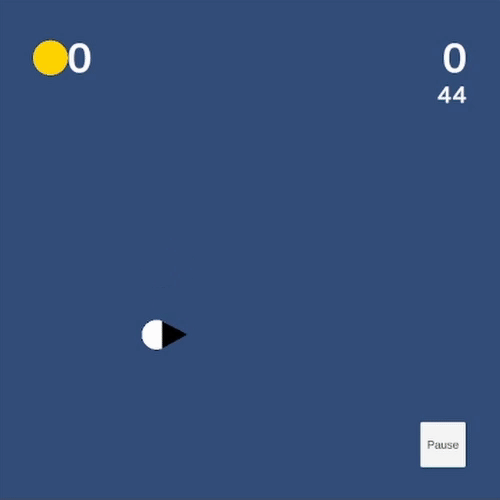Welcome to Wavebreaker Games! This is the online hub of a passionate solo game developer striving to make waves amidst the vast expanse of the ocean. Follow me for updates on this journey and behind-the-scenes glimpses into game development. Buy me a coffee!
Don't wanna be here? Send us removal request.
Text
Vision
I am struggling with the game's vision right now. I really enjoy the world I've been building, but I am not quite sure about the flappy game formula. I am still going to try to wrap my head around it, but I might just overhaul the experience, skip the first small mobile game, and dive straight into a more immersive PC experience.
#gamedev#gamedesign#gamedevelopment#indiedev#indiegamestudio#indie games#unity#unity2d#game development#gaming#indie game dev
0 notes
Text
Background
As I mentioned earlier, I have a strong desire to incorporate storytelling elements into my current project, despite it being a casual flappy game. To accomplish this, I've devised a strategy where the background serves as a platform to showcase significant events.
In order to test this concept, I conducted a quick experiment involving a thrilling hunt of a massive "powered beast" in the background, which could potentially become a recurring theme in the game world I'm constructing. Although it is currently in its rudimentary form, similar to other aspects of the game, I am establishing the groundwork for exploring various avenues in terms of game design. Subsequently, I can refine the implementation and polish all the details to enhance the overall experience.

#gamedev#gamedesign#gamedevelopment#indiedev#indiegamestudio#unity#indie games#unity2d#game development#gaming#indie game dev
0 notes
Text
Character Selection
I've been working on a character selection menu to easily test new characters in the game. In the future, I plan to set up a character shop and a lore page. The menu is currently basic, but functional.
Additionally, I have added a new character! I'm really enjoying the character creation pipeline I've established. It takes me about an hour and a half to create a character from concept to completion. They're not perfect, but I'm satisfied with the end result. There are still some areas in the pipeline that need improvement, but I believe I can resolve them with practice.

#gamedev#gamedesign#gamedevelopment#indiedev#indiegamestudio#indie games#unity#unity2d#game development#gaming#indie game dev
10 notes
·
View notes
Text
A new character
I spent today working on improving the player character I created, and I believe I have reached the limit of my current skills. However, I am satisfied with the design, as it aligns well with the overall aesthetic of the game.
Since I was pleased with the final result, I decided to establish a pipeline to replicate this process more efficiently. Now, I believe I will be able to create new characters more easily. As demonstrated in my previous post, I start with a basic character shape reference – which remains the same for all characters. Then, I add unique characteristics and personality to make each character distinct. Finally, I incorporate real-world references to add details and maintain a slightly realistic touch while preserving the vector art style. This is how I created the second witch character for the game.

#gamedev#gamedesign#gamedevelopment#indiedev#indiegamestudio#indie games#unity#unity2d#game development#gaming#indie game dev
0 notes
Text
World Board
Although I am making a mobile flappy game, I want to explore storytelling and world-building in every project that I embark on because that is something that I am very passionate about and really enjoy in every sort of media.
The method I use for world-building is one I got from a college professor who was very knowledgeable about the process. The first step is to create something that I call a World Board.

The image is blurred for obvious reasons—I don't want to spoil everything about this world—and this might be a world that I dive deeper into in future projects. But essentially, the World Board is divided into 4 sections.

The Commandments - The rules of your fictional world that cannot be broken. Write as many as you'd like, just be sure to stick to them in any step forward to make your world consistent, cohesive, and believable.
The World Events - The main events that mark the origin and development of your world. You don't really have to make a detailed outline of each event (that is something that you'll do in the next steps), but you should at least have a beginning to your world and a development that leads into the 'Present Day'. A more interesting approach (in my opinion) is to also include some sort of end to your world, just so you know how things will wrap up.
The Eras - Divide the world events into eras. Make as many as you'd like, just make sure they make sense. Think of the real world and its eras as an example: Prehistory, Classical, Middle Ages, Early Modern, and Modern eras. These are defined by key events.
Topics to explore - This should be the last section to be written on your World Board. Take a look at the board and see topics and events you'd like to explore in your projects!
I am still developing and fine-tuning this World Board, but I am really enjoying the process and how it's shaping up. Whenever I move on to the World Chronicle, I'll let you know.
#world building#gamedev#gamedesign#gamedevelopment#indiedev#indiegamestudio#indie games#unity#unity2d#game development#gaming#indie dev#indie moodboard#indie game dev
0 notes
Text
Vector Art 2D
This is a continuation of the previous post. If you haven't read it, you can catch up here.
I have been experimenting with the art style of the player character. I stopped and took a minute to look at the background, and I really enjoy the art style and direction taken with these assets. So, I decided to try making a version of the character in that style. This will also help with world building. Tomorrow, I will explain further why.
Keep in mind that this is an art style that I am not particularly familiar with (and I am not an artist by any means), but I quite like the end product, and I think I will keep this art style. However, I have to add more details and highlights to be more faithful to the asset pack.

Overall, this was a faster process than my normal hand-drawn asset pipeline might take and avoids an overhaul of the assets already implemented in the game.
Here's the character in the game:

Obviously, the model is really small in the gameplay section, so you can't see any details. That's why I think I'll add a tab where you can get the lore of characters, and there you might see the model up close.
There's also something missing to spice up the game's visuals... post-processing! But that's a post for another day.
#gamedev#gamedesign#gamedevelopment#indiedev#indiegamestudio#indie games#unity#unity2d#game development#gaming#indie game dev
0 notes
Text
Asset pipeline
Like I discussed previously, I plan on making the playable character(s 👀) from scratch, and to do so, I have to establish a viable pipeline. However, my main concern is that I haven't settled on the visual style yet. Although the mockup I created using asset packs looks acceptable, it doesn't match my personal style. Normally, I create hand-drawn assets and then digitally color them, so I'm not very accustomed or familiar with the vector art style found in the asset packs I used.
Currently, I'm considering remaking the assets in my own style and proceeding from there. I still believe it's important to create a mockup using asset bashing, as it gives me a better understanding of the assets required.
Later on, I may create a more detailed breakdown of my 2D asset pipeline. For now, I've redesigned a placeholder player character to appear less extravagant.

#gamedev#gamedesign#gamedevelopment#indiedev#indiegamestudio#indie games#unity#unity2d#game development#indie game dev#video games
1 note
·
View note
Text
Scheduling
My free time to dedicate to this project is rather limited, so I am still trying to find a sustainable schedule in which I can make decent progress and also have something to discuss every day. Right now, I have been developing/designing the game in the afternoons and writing and organizing the blog posts in the morning. This has been working so far, but I predict that at some point, I won't have huge progress to showcase. Also, I have erratic post times, and I would much rather have a set time to post. I am aiming now to switch my development and writing times, so I plan the post in the evening, then they are automatically posted at 9 am GMT, and I take advantage of the morning to work on the game (I am an early bird btw). Saturdays will be for sharing screenshots and videos of gameplay using #screenshotsaturday, and Sundays will be more introspective, as this one is. Although I haven't had a huge number of interactions/engagement so far, I enjoy structuring my thoughts and the process of development into a blog post and sending it out into the world every day, so I will continue to do so.
#gamedev#gamedesign#gamedevelopment#indiedev#indiegamestudio#unity#unity2d#game development#indie games#indiegamedev
0 notes
Text
Screenshot Saturday #1
Hey everyone! My name is Sem, and I am embarking on my solo developer journey! I am starting small but aiming to grow from there. My first project is a Flappy Bird-style game with a gravity change mechanic. The theme inspiration is Kiki’s Delivery Service, and I am currently working on the visual elements of the game. Sound is next on my list! If you'd like to keep up with my development journey, please follow my page for daily updates. Thank you!!
#screenshotsaturday#game development#gamedev#indie games#my gameplay#unity#unity2d#indiegamestudio#gamedevelopment#gamedesign#indiedev#gaming
0 notes
Text
Finding a visual direction
As you probably gathered from the previous post, gameplay is king in my book. However, the visual aspect of a game is arguably more important.
Never judge a book by its cover, but people do, and that's normal.
So when designing a product, even if you consider its functionality (i.e. gameplay) to be the reason a customer would want it, its visual elements are what draw them near enough to even see what the product does. The process of finding an art direction is one that I am constantly iterating upon, and I am not certain I've nailed it yet, but I'm getting more comfortable with it now to showcase.
First, I create a mood board. I personally do this on Pinterest (because I am lazy), but there are numerous other alternatives which might serve you better. I ended up choosing the theme from Kiki's Delivery Service but collected a variety of different references.

Then, I search through my collection of game assets that I have from Humble Bundle. Since I am not the best artist, whenever I see a game art asset bundle on there, I buy the lowest tier. It costs a buck, and you start accumulating interesting-looking assets. The problem with using premade assets is finding a coherent style. To that end, I try to use as few different asset packs as possible and decide whether I am going for a more detailed look, hand-drawn, pixel art, or vector art, and only use assets in that style.
Next, I take a screenshot of gameplay and do assetbashing photobashing using the assets. This helps me arrive at something I think looks cool. However, this doesn't mean that the final game will look like this. It's just a nice starting point, and it helps me determine which asset packs to use and customize.

Another thing is that I believe that the main elements of your game should be custom-made to give them a unique identity. In my case, the witch player character will be created by me, and I'll try to match it as closely as possible to the style of the other assets.
0 notes
Text
Blocking out a game
The process to make a video game is a long and complex one, and it's very different from developer to developer. Some might focus first on visual elements, others on story and world building, or even making a paper prototype and going from there, but that doesn't mean that one approach will particularly make a game better or worse at the end of the day.
The method I use was actually something I got from Mr. Luís António, you might know him as the developer behind Twelve Minutes. In a couple of talks, he spoke about his process to develop and plan a game, and two of his lessons really stuck with me.
First, you must feel a game before you see it or hear it, meaning that you have to take advantage of the dimension that a video game has as a medium that books or films can't replicate, and that's gameplay. Your game must be playable and enjoyable before anything else, and that's why my games start by looking like this now, while before I got too preoccupied getting placeholders for every single element.

The second lesson is for a game to stand on its feet, it needs a skeleton. What is this skeleton? A main menu, a pause menu, settings, a loading screen, a clear heads-up display, and so on. These are 'must-haves' in a game, the parts of a video game that all players are expecting even if it isn't what they're particularly looking for. So as soon as I got the core gameplay loop down, I start developing these elements without any embellishment, just checking off the requirements of the game's skeleton.

And that pretty much sums up the first phase of development.
#gamedev#gamedesign#gamedevelopment#indiedev#indiegamestudio#indie#indie games#indiegamedev#video game#game development#unity#unity2d
8 notes
·
View notes
Text
The First Project
I've made short games in the past, even released two crappy, clunky demos on the Play Store, but I haven't done a full production from start to finish.
I want to start small and build upon that. I also want to do something that's accessible and free, something that can introduce an audience to me as a developer, but also something that can generate some sort of revenue, even if small. I can't live just off of air.
That's why I'm making a mobile game. Now, before you leave, I'm making this game as a project with a smaller scope, and I'm not only planning on making mobile games, but it's a good place to start.
Now, without further ado, what I am making is… a Flappy Bird clone with a gravity change mechanic. Whenever you tap, the character switches between going up or down. Honestly, this is the type of game I play on my phone, so I want to do something I'd like to play.
Concerning the theme of the game, I am currently split between a steampunk aesthetic inspired by Treasure Planet or a modern witch/fantasy setting like in Kiki's Delivery Service.
Let me know what you think about this premise :)
0 notes
Text
Arriving at a game concept
There's something strangely soothing about opening an empty Unity project. The possibilities of what you can create from this blank slate are almost overwhelming.
That's why the first step when creating a game should be grabbing a pen and paper and writing down ideas. A professor of mine once said that all original ideas are just a bunch of existing concepts glued together by cohesive logic, making sure that it doesn't fall apart. For example, you could break down Among Us as a digital Mafia/Werewolf game with short, easy party game elements, like in 'WarioWare, Inc.: Mega Party Games!'
So, I usually start the design process by analyzing things I like from games, books, and movies, and grab concepts that I find interesting and try to match them together, discarding all that doesn't make sense. The goal is to have around 3 to 4 core concepts you can join together to make your game idea original.
3 notes
·
View notes
Text
Introduction
Hi! My name is Sem and I’ve been studying game design and development for the past 5 years, and right now I’m at a crossroads.
I can start looking for a job in the industry, kickstarting my career as a programmer, but there’s just a tiny problem with that… I live right about here, and as you can imagine, there’s not many game studios in my neighborhood.
But there's another option, I can create my own career opportunity and start making indie games, which honestly is my dream job. So I guess this account is a short form written documentation of whether I succeeded in pursuing this passion or moved on, but either way I just had to try.
#indiegames#gamedev#indiedev#gaming#gamedesign#indiegamer#gamersunite#gamerelease#indiegamestudio#gamercommunity#gamedevelopment#supportindiegames#indiegameoftheday#indiegameplay#gamejams#indiegamelover#gamingnews#game development#indie games#video games
2 notes
·
View notes
